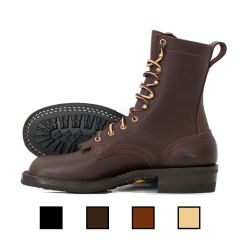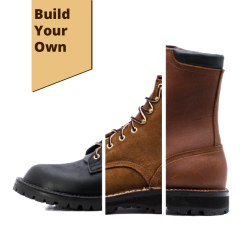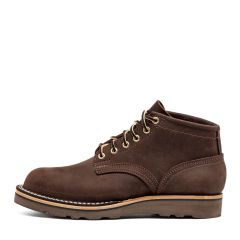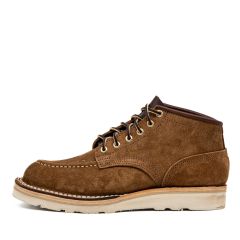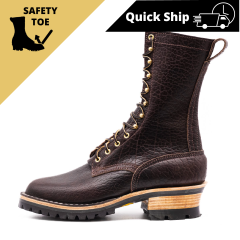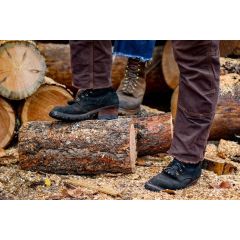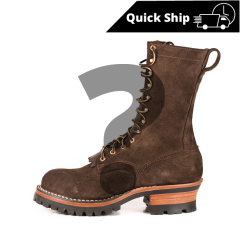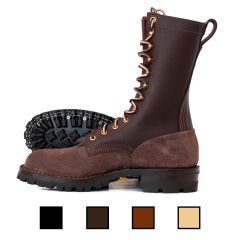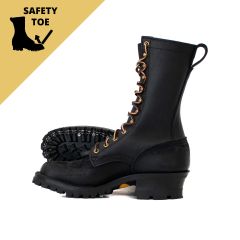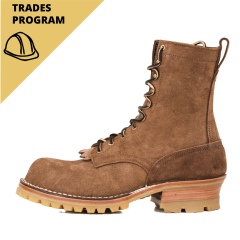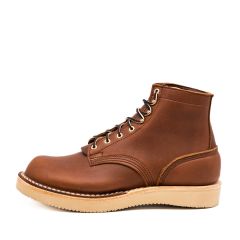Working Boots For Men
The Importance of Quality Craftsmanship in Work Boots
Every job starts from the ground up, and the right boots make all the difference. A solid foundation provides the support, protection, and durability needed to handle long shifts and tough conditions. Whether working on concrete, climbing ladders, or trekking through rough terrain, high-quality boots keep every step steady and comfortable. Here’s why investing in quality work boots improves safety, comfort, and durability on the job.
Built for Safety: Protection When It Matters Most
Every worksite inevitably comes with risks, but the right boots help prevent injuries before they happen. A well-built pair provides the grip, support, and shielding to navigate tough conditions. Full-grain leather resists abrasions, while sturdy soles keep your footing secure on uneven ground.
For a construction worker moving across scaffolding or stepping through debris, a weak sole or poorly stitched boot can lead to a costly accident. Likewise, loose gravel, exposed nails, and slick surfaces demand footwear that holds up under pressure. That’s why Nick’s Boots are crafted with thick leather uppers and reinforced soles.
Unmatched Comfort for Long Hours on Your Feet
A long shift doesn’t pause for sore feet. Standing on concrete puts constant pressure on joints while climbing and crouching can wear down muscles before the day is done. The right boots provide support that eases fatigue and keeps movement effortless.
Take an electrician moving between worksites, balancing on beams, and navigating tight spaces as a prime example. An unsupportive boot creates pressure points, which turns a simple task into a struggle. With cushioned insoles and leather that conforms to the foot, Nick’s Boots provide the lasting comfort needed to stay focused and on task.
Durability That Keeps Up With the Job
Work boots should last longer than a single season. Inferior materials break down after months of wear, leaving cracked leather, loose stitching, and worn-out soles. That’s why a job that demands long hours in tough environments calls for boots that hold strong.
Picture a logger working in thick brush, knee-deep mud, and rocky terrain. Constant exposure to moisture and rough surfaces weakens lower-quality materials, causing boots to fall apart before they’ve truly broken in. Thankfully, our are made with full-grain leather and stitched with expert precision, so any logger can confidently stand up to years of hard work.
Why Full-Grain Leather Is The Gold Standard for Durability
When it comes to the durability of men's work boots, full-grain leather stands as the pinnacle of material choice. It's not just about the rugged look or the feel of genuine leather under your fingers; it represents resilience and a commitment to quality. Nick’s Boots are made with the toughest, most resilient leather available, built for men who put their boots to work. Here’s why full-grain leather stands above synthetic and lower-grade alternatives.
Synthetic Materials Fall Apart Under Pressure
Boots made from synthetic leather might look durable at first, yet they don’t have the same strength to withstand years of hard work. These materials often crack, peel, and lose shape after months of exposure to dirt, moisture, and friction.
Imagine a mechanic working long hours in an auto shop. Oil spills, heat, and constant movement wear down synthetic boots quickly, and this leaves soles detached and uppers splitting apart. On the other hand, full-grain leather resists breakdown, holding strong no matter the environment.
Lower-Grade Leather Can’t Compete
Many mass-produced boots use top-grain or bonded leather, which is sanded down, glued together, and coated to hide imperfections. While these options may look appealing on the shelf, they lack the natural toughness to endure demanding conditions.
Let’s consider the long, labor-intensive shift of a lineman. Lineman boots take a beating every day. Long hours climbing poles, securing cables, and moving through unpredictable conditions wear down lesser materials fast. Creases form at stress points, cracks follow, and soon enough, those boots need replacing. Full-grain leather stands up to the challenge, flexing with movement instead of breaking under pressure.
Thankfully, Nick’s Boots are built for long-term reliability for lineman workers and other occupations. Every pair is designed to mold to the foot while holding its structure, creating a work boot that supports the job without wearing out.
Breathability That Keeps You Moving
Long hours on your feet lead to heat buildup, and synthetic materials only exacerbate the problem. Unlike plastics and processed leathers, which trap moisture, full-grain leather is naturally breathable, allowing airflow to keep feet cool and dry. Consider a construction worker in the heat of summer. A synthetic boot causes sweat to build up, leading to discomfort, blisters, and even foot odor. Full-grain leather allows air to circulate, preventing overheating and keeping feet comfortable from morning to night.
Built for the Long Haul
Choosing full-grain leather means investing in a boot that gets better with time, not worse. Mass-produced options need replacing every year, but Nick’s Boots are crafted to last for decades. A logger working deep in the woods needs boots he can rely on. Cheap materials would split and warp after constant exposure to rain, snow, and rocky terrain. Full-grain leather, stitched with expert craftsmanship, holds strong through every season, proving that true quality never cuts corners.
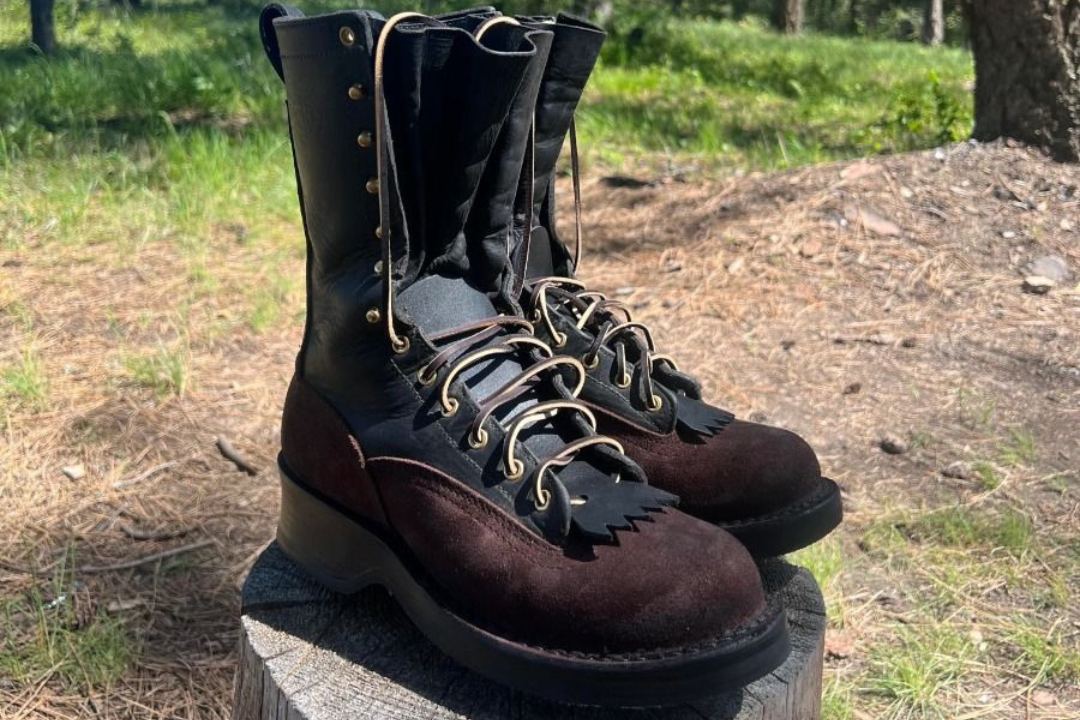
Boot Configurations for Different Work Occupations
When selecting the right working boots for men, it’s essential to consider how your occupation will influence your needs. Choosing the right configuration not only enhances comfort but also ensures your boots serve you well on the job. At Nick’s Boots, we understand the intricacies of crafting a boot that’s as adaptable as you are, regardless of your profession.
Hardware That Holds Up Through Long Hours
Laces can be a weak point if they loosen throughout the day, which forces workers to stop and readjust. The right hardware keeps boots secure, reducing strain and improving stability.
- Hooks & Eyes: Fast lacing makes these ideal for firefighters and first responders who need to gear up quickly. A firefighter stepping into his turnout gear doesn’t have time to struggle with laces. This configuration ensures a snug fit in seconds while keeping the boot flexible.
- All Eyes: Provides a locked-in, supportive fit for loggers and tradesmen who rely on stability on uneven ground. Imagine a logger trekking over slippery tree trunks—laces that come loose mid-step could lead to a fall. With all eyes, the boot stays tight, offering steady support.
- Buckles: Designed for ranchers and linemen who don’t want to stop and re-tie boots in the middle of a job. A lineman working on high-voltage lines at the top of a pole can’t risk a loose lace. A buckle setup ensures his boots stay tight, secure, and distraction-free.
Water Resistance for the Right Job Conditions
Wet boots cause discomfort, blisters, and long-term damage to the leather. Choosing the right level of water resistance ensures protection without trapping moisture inside.
- Moderate Water Resistance: Works best for warehouse workers, landscapers, and delivery drivers who deal with occasional moisture but need lightweight flexibility. A landscaper working early mornings in damp grass needs boots that repel moisture without feeling stiff.
- High Water Resistance: Designed for loggers, ranchers, and construction workers constantly exposed to rain, mud, and snow. A rancher checking fence lines in the pouring rain can’t afford soggy boots halfway through his day. Nick’s high-water-resistant boots keep feet dry and comfortable for the long haul.
Toe Styles for Protection on the Job
Every job presents unique risks. The right toe style ensures durability without sacrificing mobility.
- 4-Row Toe Cap: Extra reinforcement makes these boots essential for welders, mechanics, and heavy equipment operators who face impact hazards. A mechanic dropping a wrench onto his foot or a welder dealing with flying sparks needs that extra layer of protection.
- Moc Toe: Ideal for electricians, warehouse workers, and truck drivers who need lighter, more flexible movement. An electrician working in a tight crawl space benefits from a moc toe boot that bends without pinching, making it easier to move without sacrificing durability.
Heel Profiles That Improve Stability and Posture
A boot’s heel affects posture, balance, and long-term foot health. The right choice depends on the terrain and type of work being done.
- Logger Heel: A raised heel improves grip and balance, making it a must-have for loggers, linemen, and forestry workers. A lineman climbing utility poles all day relies on that extra elevation to keep his foot locked onto climbing pegs while preventing strain on his lower back.
- Block Heel: A lower, flat base creates steady footing for ranchers, farmers, and mechanics. A mechanic standing on concrete for ten hours needs a heel that keeps weight evenly distributed, reducing foot fatigue and joint strain.
EH-Rated Boots for Electrical Safety
Electricians and linemen face serious hazards on the job, requiring boots that meet electrical hazard (EH) standards. Nick’s EH-rated boots are designed to insulate against electrical currents, offering an essential layer of safety for utility workers and electricians. A journeyman electrician working in wet conditions needs boots that prevent electricity from traveling through the ground, reducing the risk of accidental shocks.
Sole Stitching That Holds Strong in Tough Conditions
The stitching that holds a boot together determines how well it resists wear and tear. Different sole stitching options cater to different job demands.
- Standard Stitching: A reliable choice for warehouse workers, light tradesmen, and landscapers who need solid reinforcement without extra bulk.
- Fire-Resistant, Self-Extinguishing Thread: Built for welders, firefighters, and foundry workers who work around extreme heat. A foundry worker dealing with molten metal needs boots that won’t burn or weaken when exposed to high temperatures.
- 360° Standard Stitching: Added reinforcement around the entire sole makes this the best option for loggers, construction workers, and heavy-equipment operators who put serious stress on their boots. Construction workers who stomp through rebar, wet concrete, and crushed gravel need soles that won’t separate under pressure.
- 360° Technora Stitching: The most advanced option, offering heat and chemical resistance for wildland firefighters, utility workers, and oil rig workers. A firefighter battling a wildfire in extreme heat and uneven terrain needs boots that withstand fiery conditions.
Frequently Asked Questions on Working Boots for Men
What is the difference between steel toe and composite toe working boots?
Steel toe boots are known for their superior protection, using a steel cap to shield your toes from heavy impacts or compression. Composite toe boots offer safety with non-metallic materials like plastic or Kevlar, making them lighter and more comfortable for prolonged wear, and they won't set off metal detectors.
How do I break in new working boots?
Breaking in boots involves wearing them for short periods initially and gradually extending the wear time. Flex them gently by hand to loosen up the leather. Our boots are crafted from full-grain leather, which will mold to the shape of your foot over time, providing a custom-like fit unique to you.
What features should I look for in a good pair of working boots?
Choosing the right work boot depends on the conditions it will be exposed to. For durability, always opt for full-grain leather. A rubber sole with deep tread improves traction, essential for workers navigating slick or uneven terrain. Likewise, padded collars and cushioned insoles provide added comfort, especially for those standing on concrete for long hours. Electricians should look for EH-rated soles for protection against electrical hazards, while workers in wet conditions will benefit from waterproof or water-resistant treatments.
Are there working boots that accommodate orthotics?
Yes! Many of Nick’s Boots are designed with removable insoles, allowing room for custom orthotics. For workers with foot pain, flat feet, or long shifts on unforgiving surfaces, a boot with an accommodating footbed provides essential support. Whether adding arch support or using a specialized insert to reduce strain, a well-fitted boot makes all the difference in preventing fatigue and discomfort over time.
Are there working boots that are waterproof?
Absolutely! For those who occasionally deal with wet conditions, water-resistant boots repel light moisture and remain flexible, which makes them a great fit for warehouse workers, landscapers, and delivery drivers who need breathable protection. Jobs that involve continuous exposure to rain, mud, or standing water, can also benefit from waterproof boots. These are especially useful for loggers, ranchers, and construction workers who spend their entire shifts outdoors
How do I choose the right size for my working boots?
Measure your feet, preferably at the end of the day when they are at their largest, to get an accurate fit. Compare measurements with our size chart. Our boots are known for their snug fit that loosens with wear, so ensure a balance between comfort and security.
Are there insulated working boots for cold weather?
Absolutely. For those braving colder climates, we offer insulated options ensuring your feet stay warm and dry, even in the most frigid conditions. These boots provide exceptional protection without sacrificing comfort.
How often should I replace my working boots?
The lifespan of a boot depends on the conditions it faces and how well it’s maintained. Generally, heavy-use environments like construction sites or logging camps put boots through daily stress, often requiring a replacement within a year or two. Jobs with moderate wear, such as warehouse work or farming, may allow boots to last longer with proper care. Inspecting boots regularly helps determine when it’s time for a new pair.
